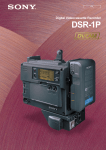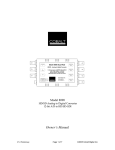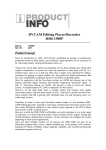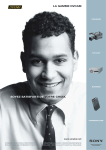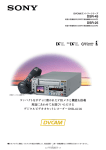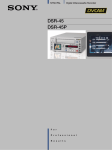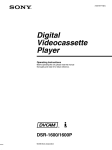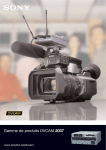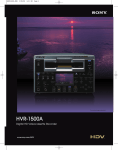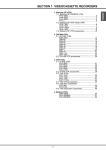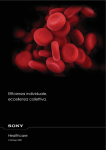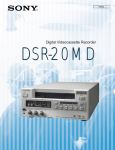Download DSR-80/DSR-60 - BroadcastStore.com
Transcript
NTSC Digital Videocassette Recorder DSR-80/DSR-60 Digital technology has opened up new opportunities in every business arena and professional video production is no exception. The migration toward digital brings great advances in image quality and equipment versatility. The DVCAM™ format, originated in 1996, offers professional reliability and system flexibility which meets the demanding requirements of video professionals. Incorporating excellent editing capabilities, great picture and multigeneration quality, and superb tape durability, the DVCAM format offers exceptional digital performance. In terms of flexibility, DVCAM VTRs offer several integration alternatives by incorporating both digital and analog interfaces for totally digital systems or hybrid analog systems. DVCAM VTRs incorporate a dual-size cassette mechanism which accepts both mini and standard cassette tapes (without an adaptor) for record or playback for up to 3 full hours! In addition, both Sony’s professional DVCAM format and consumer DV format use advanced metal evaporated tape. This enables consumer DV recorded tapes to play back in DVCAM VTRs and vice versa. The DSR-80 Editing Recorder provides excellent editing performance with convenient features such as the RS-422A Remote Control Interface, Time Code Generator/Reader, Frame Accurate Editing capability and more. Incorporating an RGB Output, a Closed Caption function and Auto Repeat function with a Power-on Playback capability, the DSR-60 Feeder Player is ideal for a wide range of applications not only in editing but also in a large-screen, high quality video presentation. The digital features such as ClipLink™ operation is achieved by the optional SDI and SDTI(QSDI™) interfaces. Of course, a full complement of analog interfaces are available for easy integration into current analog systems. Providing the superb performance of the DVCAM format and a wide range of operational functions, the DSR-80 and the DSR-60 are the right choice for video professionals looking for creative tools in a high quality digital environment. * The SDTI (Serial Data Transport Interface) is defined as SMPTE 305M. The SDTI(QSDI) is the DV signal interface which conforms to the SDTI. Features The DVCAM Recording Format - Digital Recording for the Next Generation The DSR-80 and the DSR-60 offer superb picture quality, multi-generation capability and production flexibility thanks to the adoption of the new DVCAM digital recording format, which has been developed by Sony for professionals working in the digital environment. 16kbit IC memory, which stores data to enhance editing efficiency. Two cassette sizes are available; DVCAM Standard size cassette provides a maximum recording time of 184 minutes (PDV-184ME) and the DVCAM Mini size cassette records up to 40 minutes (PDVM-40ME). Tape Direction <IC memory> Sub Code Video ion ect Dir ad He 6.35 mm (1/4 inch) High Efficiency in the Editing Environment SDTI(QSDI) Digital Interface Audio ITI ITI: Insert and Track Information Playback Compatibility with Home-Use “DV” Format The DVCAM digital recording format for video professionals is an extension of the consumer DV format. Therefore, it maintains playback compatibility with consumer DV recordings and has the advantage that both standard and mini cassettes can be used in the same machine. By maintaining a wider track pitch, the DVCAM format ensures high reliability for the professional editor. The DVCAM Component Digital Recording Format The DVCAM format uses 8 bit component digital recording with a 5:1 compression ratio and sampling at the rate of 4:1:1 to provide superior picture quality and multi-generation capability. The DVCAM format employs an intra frame compression scheme which is ideal for editing applications. Based on DCT (Discrete Cosine Transform) techniques, each frame consists of 10 tracks. Each track has ITI (Insert and Track Information), Audio, Video, and sub code areas. The ITI, which is a reference signal used for precise tracking, and Time Codes on the sub code area assure highly accurate editing performance. This technique provides much greater operational flexibility for complex multi-layering. High Quality Digital Audio The DSR-80 and the DSR-60 provide two selectable audio channel modes, two channels and four channels. In order to ensure superb audio performance with a wide dynamic range and an excellent signal-to-noise ratio, the PCM (Pulse Code Modulation) digital stereo recording system is used in both modes; 2CH of 16 bit, 48kHz sampling frequency and 4CH of 12 bit, 32kHz sampling frequency. Excellent Performance by the Professional DVCAM Tapes To gain maximum performance from high density digital recording, new Advanced Metal Evaporated cassette tapes have been developed for the DVCAM format. The result is superior recording quality which is achieved by increasing the RF video output by +4.5dB compared to that of Hi8® metal evaporated tape. Higher durability is also ensured for professional editing applications by enhancing protection with DLCTM (Diamond Like Carbon) coating. Each cassette has a The DSR-80 is equipped with a SDTI(QSDI) interface, while this interface is available with the DSR-60 as an option (DSBK-110 QSDI Output Board), which handles compressed video as well as Sub Code data and digital audio signals of the DVCAM recording format. The SDTI(QSDI) interface allows degradation-free transfer of both video and audio signals between the DSR VTRs and between the VTRs and a Sony EditStationTM in a nonlinear editing system. ClipLink Operation The ClipLink system is a comprehensive data management system of the shooting information which is necessary for the total digital production process, ranging from acquisition to editing. Incorporated into Sony DVCAM cassettes is an IC memory chip which holds shot list information, called a ClipLink Log Data. When the cassette is loaded into the DSR-80 or the DSR-60, the ClipLink Log Data is uploaded into the Sony EditStation system for immediate viewing of the images on the GUI (Graphical User Interface) screen before actually being recorded onto the hard drive. Then only the selected clips on the GUI screen may be uploaded for time and space-saving efficiency of the hard drive. Thus, both the DSR-80 and the DSR-60 perform highly effective roles, when integrated into a nonlinear editing system with such as Sony’s EditStation system. Full Tape Dubbing with ClipLink Log Data The DSR-80 has a full tape dubbing function which allows you to make a dub of the recorded DVCAM tape information (video/audio/sub code) along with the ClipLink Log Data in the memory IC contained in the DVCAM cassette tape. The dubbing is accomplished by operating the menu button on the subcontrol panel via the SDTI(QSDI) interface and the RS-422A. Versatility for Current System Environments The DSR-80 and the DSR-60 have been specially designed for easy integration into existing analog editing systems. In addition to versatile digital interfaces, the DSR-80 and the DSR-60 provide full analog interfaces. Remote Control via RS-422A The DSR-80 and the DSR-60 are equipped with an RS-422A serial communication port to interface with Sony VTRs and editing controllers such as the PVE-500. In addition to VTR control functions, the interface also enables the transfer of ClipLink Log Data from the cassette memory in the DVCAM cassette to a Sony EditStation system. Analog Interfaces The DSR-80 and the DSR-60 provide a full complement of analog interfaces for video and audio, which offers compatibility with conventional analog equipment, such as Betacam SPTM , Hi8 and S-VHS for a smooth and gradual transition to digital systems. For video, composite, component and S-video connections are provided. Four channel or two channel (selectable) inputs (DSR-80 only) and outputs are provided for audio. Comprehensive Editing Features Built-in SMPTE Time Code Generator/Reader A built-in time code generator (DSR-80 only) and reader are in the DSR-80 and the DSR-60 to offer precise video editing. The time code conforms to the SMPTE standard. Time code written in the sub code is controlled via the RS-422A interface port. Input (DSR-80 only)/output of time code is possible with the optional DSBK-130 Time Code Input/Output Board. Time Base Corrector The DSR-80 and the DSR-60 are equipped with a built-in time base corrector for all analog outputs giving highly stable video signals. Sync and SC phase adjustment is made from the front panel, while the TBC control is possible with the optional UVR-60 TBC Remote Control Unit. accurate editing is assured in both modes, thanks to the sophisticated servo control and built-in time code generator (the DSR-80 only) and reader. In the insert mode of the DSR-80, video, audio and time code can be inserted independently or in any combination. In the assemble mode, all of the prerecorded signals (video, audio and time code) are erased and replaced with new signals. High Speed Picture Search The DSR-80 and the DSR-60 offer high speed picture search which provides a recognizable picture at various speeds over a range of up to 32 times normal speed, in both forward and reverse, to speed editing operations. In JOG mode, frame accurate picture search is possible. These functions are available using the optional DSRM-10 Remote Control Unit or with editing controllers equipped with RS-422A capability. *The search speed varies with the type of controllers. In case of the DSRM-10, the search speed is up to 16 times. Jog Audio It is possible to reproduce four channels or two channels of digital audio from the speed of 1/30 to 1 times normal playback speed, both in forward and reverse, in the JOG mode. This feature is helpful for quickly and precisely designating editing points while monitoring the digital audio signals. The audio data is held in memory and output according to search speed for enhanced recognition. Sony Integrated Remote Control System (SIRCS) The DSR-80 and the DSR-60 are equipped with a SIRCS (Sony Integrated Remote Control System) interface on the front panel, enabling connection of the optional DSRM-10 Remote Control Unit for controlling jog, shuttle, playback, record, pause, fast forward and rewind functions. Serial Digital Interface (SDI) <DSRM-10> The SDI (Serial Digital Interface) which conforms to the SMPTE broadcast standard, is supported by the optional DSBK-120 to the DSR-80 and the optional DSBK-100 SDI Output Board to the DSR-60 for simple connection with other SDI equipped devices such as D-1 and Digital BETACAMTM VTRs. Digital Slow Function The Digital Slow function takes advantage of digital processing for playback at 0.39 times (DSR-80) and 0.33 times (DSR-60) normal playback speed both in forward and reverse, achieving noiseless slow-motion images. Either frame or field accurate playback is possible. Frame Accurate Editing Capability When connected to RS-422A equipped editing controllers, the DSR-80 and the DSR-60 function as an editing recorder and an editing player for assemble or insert editing. Frame DSR-80 Convenient Functions for High Quality Video Playback Auto Repeat and Power-on Playback Function (DSR-60 only) The auto repeat function enables either the entire tape or a specific portion of the tape to be replayed continuously. By simply selecting A and B points, or presetting the time codes on the setup menu, the DSR-60 plays back the selected segment repeatedly. Furthermore, the power-on function allows the DSR-60 to playback video programs immediately upon turning the power switch on. RGB and Y/R-Y/B-Y for High Picture Quality Video Presentation The DSR-80 and the DSR-60 are ideally suited for an RGB environment, such as large-screen, high-quality video presentations and computer environments. This is because RGB signals can be converted into Y/R-Y/B-Y component signals with minimum picture degradation. With the RGB/Component Out switch set to RGB, the DSR-80 and the DSR-60 supply high-quality RGB signals, while the DSR-80 also accepts input signals. Closed Caption Function The DSR-80 and the DSR-60 have a closed caption function which reproduces the program with the recorded signal on the video area as video auxiliary data. Furthermore, the DSR-80 can record character data on the video area. User Friendly Operation Ease of Initial Set-up for Convenient Operation The DSR-80 and the DSR-60 have an initial setup menu system. The setup menu is programmed in the form of a layer structure. By simply going through the menu using the subcontrol panel, users can easily initialize the VTR. This setup menu allows many detailed operational parameters to be preset. Once the menu is set, the DSR-80 and the DSR-60 will memorize the options and retain them in memory even after the power is turned off. By using these memorized set-up parameters, the DSR-80 and the DSR-60 can be immediately set up for a specific <DSR-60> application. Built-in Character Generator The DSR-80 and the DSR-60 have a built-in character generator which superimposes characters on the video signal output from the VIDEO OUT 2 terminal. The time code data (TC, User bit), VTR operation status, menu items, and all alarm, warning, and error messages can be shown on a monitor. Legible Front Panel Display The DSR-80 and the DSR-60 have a large, highly visible display on their front panels. This display shows a variety of information such as audio and video input mode, normal/high- <DSR-80> DSR-60 speed modes. ClipLink data and cassette memory status can also be displayed. Consumer DV Playback The DSR-80 and the DSR-60 have the capability to playback consumer DV cassettes, thus enabling broader acquisition program material to be used without the need for a special adapter. Jog Audio and Digital Slow functions can still be used. Therefore, the DV recordings can be used as editing sources in the editing environment. * The DSR-80 and the DSR-60 do not support LP mode of the consumer DV. Reliable, Responsive and Serviceable The DSR-80 and the DSR-60 were designed with a highly responsive mechanism, which is an essential factor for efficient editing operation. In addition, maintaining excellent responsive performance, the DSR-80 and the DSR-60 offer ease of servicing and maintenance by incorporating self-diagnostics, an error log and hours meter. Quick Responsive Mechanism The DSR-80 and the DSR-60 assure high reliability in all professional applications through U-loading, direct reel drive, and an electronic tension servo. The FF/REW speeds are impressive 85x, while maximum search speed is 32x with color playback. Self-Diagnostics and Error Log Should an error be detected, an error message will be displayed which will identify the problem area. In this way, down-time can be minimized. Moreover, the error log function makes it easier to detect the error by retaining the past status data of the DSR-80 and the DSR-60 in memory. Hours Meter An hours meter is also built-in to assure simplified maintenance by showing total operating time, drum rotation time, transport operation time, and number of thread/unthread operations. This information can be shown on a monitor screen and the front panel display of the unit. Appealing, Simple, Design The attractive and functional appearance of the DSR-80 and the DSR-60 has evolved through many years of experience. It was designed to complement the Sony EditStation systems and other Sony equipment for heightened esthetics demanded by creative professionals. The DSR-80 and the DSR-60 are four units high and are EIA standard 19-inch rack mountable with Sony’s optional RMM-130 Rack Mount Kit. System Configurations Efficient Nonlinear Editing This system shows an integrated digital editing system, from image acquisition to final post production. It provides maximum system multi generation picture quality because the data is transferred via SDTI(QSDI) interfaces without the process of compression and decompression, or conversion between DSR-80 Editing Recorder analog and digital. Furthermore, the highly DSR-60 efficient ClipLink operation enhances the Editing Player entire editing process. X1 SDTI(QSDI) RS-422A DSR-130 Digital Camcorder ES-3 EditStation DVCAM Tape DSR-500/300 Digital Camcorder Conventional Linear A/B Roll Editing System DSR-80 Editing Recorder Y N O S In the evolution of a conventional A/B roll editing system, the DSR-80 and the DSR-60 will be an essential element in the smooth transition Analog Component to a future digital system. When integrated with current UVW DFS-300/500 series of VTRs, the DSR-80 shows its excellent DME Switcher performance as an editing recorder, while Analog Component the DSR-60 as an editing player, DSR-60 RS-422A Editing Player takes advantage of its built-in digital and analog DVCAM Tape RS-422A component interfaces. DSR-130 Digital Camcorder PVE-500 00 :0 0. 00 . BET ACA M SP RS-422A Editing Control Unit UVW-1600 Betacam SP Editing Player DSR-500/300 Digital Camcorder Digital Dubbing System Digital dubbing can be done between the DSR-60 and the DSR-80 without any additional controller. The recorded DVCAM tape information (video/audio/sub code) along with the ClipLink Log Data in the Cassette Memory can be dubbed with degradation-free quality. DSR-80 Editing Recorder SDTI(QSDI) RS-422A DSR-60 Editing Player RS-422A Peripheral Equipment DSR-130 DSR-300 ES-7 DSBK-100 Digital Camcorder (Consists of DSR-1 Digital Videocassette Recorder and DXC-D30 Digital Camera) Digital Camcorder EditStation System SDI Output Board DSBK-110 DSBK-120 DSBK-130 DSRM-10 QSDI Output Board SDI Input/Output Board Time Code Input/Output Board Remote Control Unit RMM-130 UVR-60 PVE-500 DFS-500 Rack Mount Kit TBC Remote Control Unit Editing Control Unit DME Switcher RM-450A RCC-5G/10G/30G PDVM-12ME/22ME/32ME/40ME Editing Remote Controller Remote Control Cable (5 m, 10 m, 30 m) Digital Video Cassette (Mini size) PDVM-32N/40N (Mini size) PDV-64N/124N/184N (Standard size) PDV34ME/64ME/94ME/124ME/184ME Digital Video Cassette (Standard size) PDVM-32MEM/40MEM (Mini size) PDV-64MEM/124MEM/184MEM PDVM-12CL (Mini size) PDV-12CL (Standard size) (Standard size) Digital Video Cassette (Master Tape) Cleaning Cassette Tape Digital Video Cassette (Non IC Type) Specifications DSR-80 DSR-60 GENERAL Power requirements Power consumption Operating temperature Storage temperature Operating humidity Storage humidity Mass Dimensions (W x H x D) Tape speed Recording/Playback time AC 100 to 120 V, 50/60 Hz 140 W 85 W 5 °C to 40 °C (41 °F to 104 °F) -20 °C to 60 °C (-4 °F to 140 °F) Less than 80 % Less than 90 % 19 kg (41 lb 14 oz) 18 kg (39 lb 10 oz) 427 x 174 x 494 mm excluding external projections (16 7/8 x 6 7/8 x 19 1/2 inches) 28.193 mm/s Standard size: More than 184 min. w/PDV-184ME/184N Mini size: More than 40 min. w/PDVM-40ME/40N Fast forward/Rewind time Standard size: Less than 3 min. w/PDV-184ME/184N Mini size: Less than 1 min. w/PDVM-40ME/40N Search speed When controlled via RS-422A: Search speed is up to 32 times, forward and reverse. When controlled via optional DSRM-10: JOG mode: Frame by frame to x2, forward and reverse SHUTTLE mode: 8 steps, still to x16 normal speed, forward and reverse Digital slow mode: 3 steps, still, x1/5 and x1/10 normal speed, forward and reverse JOG audio mode: x1/30 to x1, forward and reverse VIDEO PERFORMANCE Band width (via analog component I/O) Luminance: Chrominance: S/N ratio (via analog component I/O) K-factor (K2T, KPB) Y/C delay 30 Hz to 5.0 MHz ±1.0 dB 5.75 MHz +0/-3.0 dB (Typical measurement) 30 Hz to 1.5 MHz +1.0/-5.0 dB More than 55 dB Less than 2.0 % Less than 30 ns AUDIO PERFORMANCE Frequency response 2CH mode (48 kHz/16-bit): 4CH mode (32 kHz/12-bit): Dynamic range Distortion (THD + N) 20 Hz to 20 kHz +0.5/-1.0 dB 20 Hz to 14.5 kHz +0.5/-1.0 dB More than 85 dB Less than 0.05 % SIGNAL INPUTS <VIDEO> ANALOG REF. VIDEO Composite, 1.0 Vp-p, 75 Ω, sync negative (BNC x2, loop-through connection) VIDEO Composite, 1.0 Vp-p, 75 Ω, — (BNC x2, loop-through connection) sync negative RGB/COMPONENT* (BNC x3) *selectable Y/R-Y/B-Y: Y: 1.0 Vp-p, 75 Ω, — sync negative R-Y/B-Y: 0.7 Vp-p, 75 Ω (75 %) R. G (w/o Sync). B: 0.7 Vp-p, 75 Ω — G (w/Sync): 1.0 Vp-p, 75 Ω, sync negative — S-Video (DIN 4-pin x1) Y: 1.0 Vp-p, 75 Ω, sync negative — C: 0.286 Vp-p, 75 Ω (at burst level) — DSR-80 DSR-60 DIGITAL SDI* (BNC x2, active-through connection) Conforms to Serial Digital Interface (270 Mbps), SMPTE 259M — * Using Optional DSBK-120 (SDI Input/Output Board) SDTI(QSDI) (BNC x1) <AUDIO> ANALOG AUDIO (XLR 3-pin female x4) DIGITAL AES/EBU (XLR 3-pin male x2) <TIME CODE> Time Code In* (BNC x1) Conforms to SDTI (270 Mbps), SMPTE 259M — -9 dBu to 28 dBu, 600 Ω/10 kΩ, balanced — 110 Ω, balanced — 0.5 Vp-p to 18 Vp-p, 3 kΩ, unbalanced — * Using optional DSBK-130 (Time Code Input/Output Board) SIGNAL OUTPUTS <VIDEO> ANALOG REF. VIDEO (BNC x1) Black Burst: 0.286 Vp-p, 75 Ω, sync negative Composite Sync*: 2.0 Vp-p, 75Ω, sync negative *When not adding sync to RGB output. VIDEO 1/2 (SUPER) (BNC x2) Composite, 1.0 Vp-p, 75 Ω, sync negative COMPONENT* (BNC x3) *selectable Y/R-Y/B-Y: Y: 1.0 Vp-p, 75 Ω, sync negative R-Y/B-Y: 0.7 Vp-p, 75 Ω (75 %) R. G (w/o Sync). B: 0.7 Vp-p, 75 Ω G (w/Sync): 1.0 Vp-p, 75 Ω, sync negative S-Video (DIN 4-pin x1) Y: 1.0 Vp-p, 75 Ω, sync negative C: 0.286 Vp-p, 75 Ω (at burst level) DIGITAL Conforms to Serial Digital Interface (270 Mbps), SMPTE 259M SDI* (BNC x2) * Using Optional DSBK-120 (SDI Input/Output Board) for DSR-80, DSBK-100 (SDI Output Board) for DSR-60 SDTI(QSDI)* (BNC x1) Conforms to SDTI (270Mbps) * Using optional DSBK-110 (QSDI Output Board) for DSR-60 <AUDIO> ANALOG AUDIO (XLR 3-pin male x4) 4 dBu, 600 Ω loading, low impedance, balanced AUDIO MONITOR (RCA phono jack x1) -6 dBu, 47 kΩ, unbalanced HEADPHONES (JM-60 headphone jack x1) -16 dBu, 8 Ω, unbalanced DIGITAL 2 to 7 Vp-p,110 Ω, balanced AES/EBU — (XLR 3-pin male x2) <TIME CODE> Time Code Out* (BNC x1) 2.2 Vp-p, 600 Ω, unbalanced * Using optional DSBK-130 (Time Code Input/Output Board) REMOTE RS-422A 9-pin multi connector (x1) TBC D-sub 15-pin connector (x1) CONTROL-S (SIRCS) Stereo mini jack (x1) SUPPLIED ACCESSORIES AC power cord (x1), RCC-5G Remote Control Cable (x1) Operating instructions (x1), ClipLink Guide (x1) *0dBu = 0.775Vrms ©1999 Sony Corporation. All rights reserved. Reproduction in whole or in part without written permission is prohibited. Features and specifications are subject to change without notice. All non-metric weights and measures are approximate. Sony, Betacam SP, DVCAM, Digital BETACAM, EditStation, i.LINK, QSDI, and ClipLink are registered trademarks of Sony Corporation. Distributed by MK4197V6TC99MAR Printed in Japan









